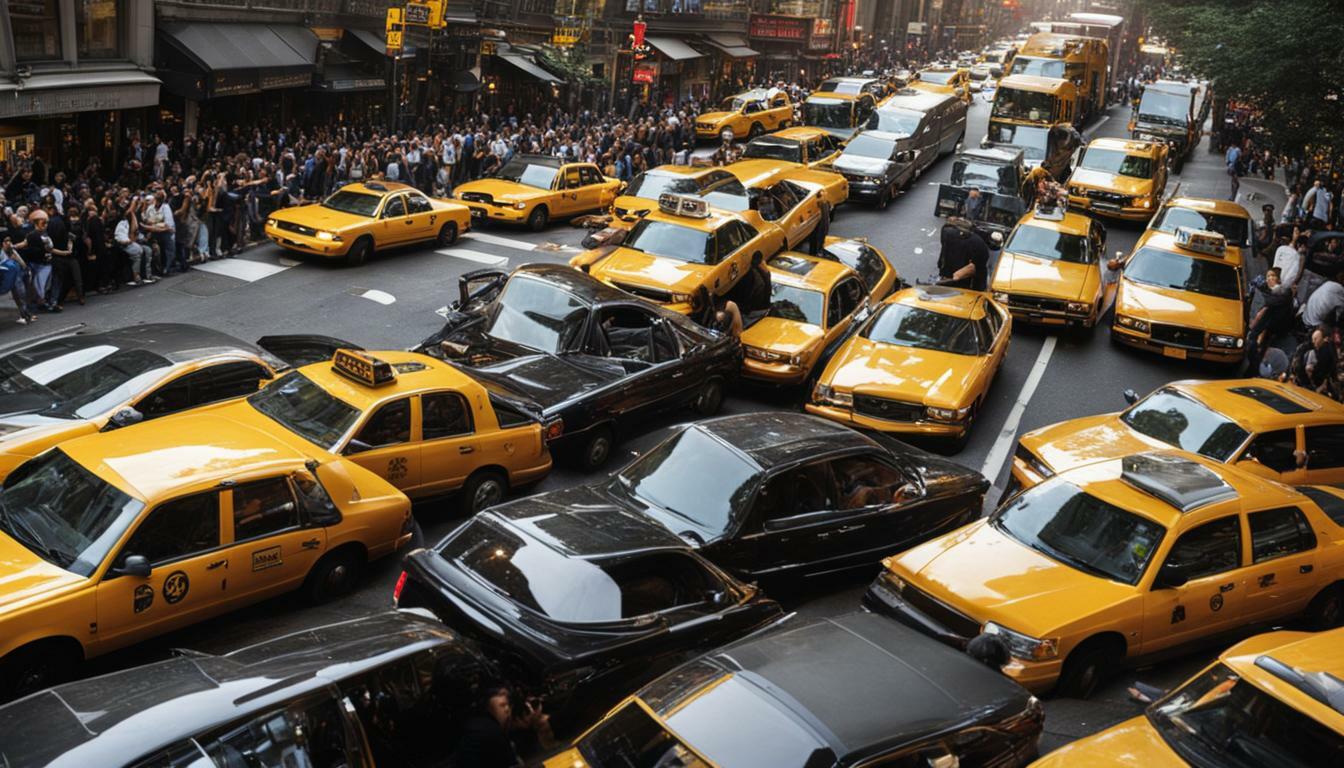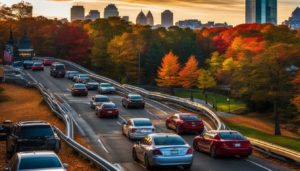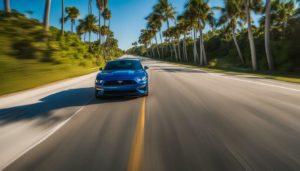Driving in New York City
Driving in New York City can be a daunting task, with its bustling streets and complex traffic rules that every driver must navigate. While public transportation options are readily available and often recommended, there are times when driving becomes unavoidable. In such cases, it is crucial to understand the rules of the road and be prepared for the challenges that lie ahead.
Key Takeaways:
- Understand and abide by the specific regulations for turning, parking, and blocking intersections in New York City.
- Be aware of tolls on bridges and tunnels and make sure to have the necessary payment.
- Avoid using handheld devices while driving, as it is illegal in New York City.
- Know the blood alcohol content limit for driving under the influence and never drink and drive.
- Smoking in the car is prohibited when driving with a child under 18.
- Stay alert for pedestrians who may jaywalk and always exercise caution.
- Familiarize yourself with the options for parking, as street parking is limited and regulations must be followed.
- Consider using parking garages, which can be more affordable and convenient.
- When driving into, out of, and around Manhattan, be aware of the various bridges, tunnels, and expressways that can be used for efficient commuting.
Best Time to Drive in NYC
Finding the right time to drive in New York City can make a significant difference in your experience on the city's busy streets. As someone who has navigated the bustling streets of NYC, I understand the importance of timing and planning when it comes to driving in the city. Here are some tips to help you determine the best time to hit the road and make your commute a little smoother.
1. Avoid Rush Hours
New York City is notorious for its heavy traffic during peak hours. To minimize your time spent in traffic jams, try to avoid driving during rush hours, which typically occur between 7:00 AM to 10:00 AM and 4:00 PM to 7:00 PM on weekdays. If you have some flexibility in your schedule, consider adjusting your work hours to avoid the busiest times or try using public transportation during these peak periods.
2. Early Mornings or Late Evenings
If your schedule allows, driving in the early mornings or late evenings can be a great way to bypass the worst of the traffic. Many people are still waking up or already at home during these times, resulting in lighter traffic and shorter commute times. Take advantage of these quieter periods to make your drive more enjoyable and stress-free.
- Early mornings: Before 7:00 AM
- Late evenings: After 8:00 PM
3. Weekends and Holidays
One of the best times to drive in New York City is during weekends and holidays when the volume of traffic is significantly reduced. Not only will you encounter fewer cars on the road, but parking may also be more readily available. Plan your trips for these times whenever possible, and enjoy a more relaxed driving experience.
Remember, while these are general recommendations, it's essential to consider specific events or road closures that may affect traffic conditions. Stay informed and be prepared to adjust your plans accordingly. By strategically choosing your driving times, you can navigate the streets of New York City with greater ease and efficiency.
| Time | Traffic Level |
|---|---|
| Rush Hours (Weekdays) | High |
| Early Mornings | Low to Moderate |
| Late Evenings | Low to Moderate |
| Weekends and Holidays | Low |
Parking in New York City
Parking in New York City can be a challenge, but with some knowledge and planning, finding a spot doesn't have to be a nightmare. The city has limited street parking, and regulations must be carefully followed to avoid tickets and towing. Fortunately, there are also parking garages available throughout the city, offering a more convenient and often more affordable option.
Street Parking
When it comes to street parking in New York City, it's important to be familiar with the regulations. Parking signs can be confusing and vary from block to block, so it's essential to carefully read the posted signs before leaving your vehicle. Pay close attention to the specific hours and days when parking is allowed and any time limits or restrictions that may apply.
Additionally, be aware of alternate side parking rules, where you are required to move your vehicle to the other side of the street on specific days to allow for street cleaning. Failure to comply with these rules can result in fines and towing. To make things easier, there are websites and apps available that provide real-time information on street parking regulations and availability.
Parking Garages
If street parking seems too complicated or you prefer a more secure option, parking garages are a great alternative. New York City has numerous parking garages scattered throughout the city, providing a convenient solution for drivers. These garages offer a variety of hourly, daily, and monthly parking rates, allowing you to choose the option that best fits your needs.
When using a parking garage, it's important to carefully review the pricing and any additional fees, such as overnight charges or extra charges for oversized vehicles. Some garages also offer discounts for pre-booking or using certain payment methods, so it's worth doing some research to find the best deal.
Summary
In summary, parking in New York City requires knowledge of the rules and careful planning. While street parking can be limited and come with strict regulations, parking garages provide a convenient and often more reliable option. By familiarizing yourself with the parking regulations and considering the use of parking apps or websites, you can navigate the city's parking challenges with ease.
More information about parking in New York City, including specific enforcement guidelines and available parking garages, can be found on the official website of the Department of Transportation.
Road Conditions in NYC
Road conditions in New York City can vary greatly, from smooth stretches of asphalt to pothole-ridden avenues and congested roadways. Navigating the city's streets requires drivers to be vigilant and adaptable to the ever-changing conditions.
One of the biggest challenges drivers face in New York City is the presence of potholes. These road imperfections can be particularly prevalent after a harsh winter, causing inconvenience and potential damage to vehicles. It is important for drivers to exercise caution and be prepared to maneuver around potholes to ensure a smooth and safe journey.
In addition to potholes, New York City is notorious for its traffic congestion. The city is densely populated, and rush hour can lead to gridlock on major thoroughfares. It is advisable for drivers to plan their routes accordingly, utilizing real-time traffic updates and alternative routes to avoid the busiest areas during peak travel times.
When it comes to road repairs and construction, drivers should be prepared for detours and delays. New York City is constantly undergoing infrastructure improvements, which can lead to temporary closures and disruptions to regular traffic flow. Staying informed about ongoing construction projects and being patient while navigating around them is essential.
| Challenges | Tips for Drivers |
|---|---|
| Potholes | Be vigilant and maneuver around potholes to avoid vehicle damage. |
| Traffic Congestion | Plan routes ahead of time, utilize real-time traffic updates, and explore alternative routes. |
| Road Repairs and Construction | Stay informed about ongoing projects, be prepared for detours, and practice patience while navigating around construction areas. |
Tips for Smooth Driving in NYC
- Be alert and attentive at all times, as New York City streets can be unpredictable.
- Use turn signals and adhere to the city's strict regulations for turning and lane changes.
- Follow the speed limits and be cautious of pedestrians, who often jaywalk.
- Avoid unnecessary honking, as it is technically illegal and can escalate the already bustling urban environment.
In conclusion, driving in New York City can present various challenges due to the city's unique road conditions and heavy traffic. However, with careful planning, awareness of the rules and regulations, and a flexible attitude, drivers can navigate the city's streets safely and efficiently.
Driving Tips for NYC
Driving in New York City requires a certain set of skills and awareness, especially when maneuvering through the narrow streets of Manhattan. To navigate the bustling city streets like a pro, here are some essential driving tips:
- Be prepared for heavy traffic: New York City is known for its congestion, so it's important to mentally prepare for slow-moving traffic. Avoid rush hours if possible, and consider using navigation apps to help you find alternative routes.
- Stay alert and watch for pedestrians: The city is always bustling with pedestrians, so stay vigilant and be prepared for jaywalkers. Be extra cautious near crosswalks and intersections, as pedestrians often have the right of way.
- Master parallel parking: Street parking in NYC can be a challenge, but with practice, you can become a parallel parking pro. Take your time, use your mirrors, and don't be afraid to ask for help from a passenger if needed.
- Know the parking regulations: NYC has strict parking regulations, so be sure to read street signs carefully and follow the posted rules. Familiarize yourself with parking garages in your area for a more convenient and affordable parking option.
When it comes to driving in New York City, being patient, cautious, and aware of your surroundings is key. Remember to follow all traffic rules, avoid unnecessary honking, and be respectful of other drivers and pedestrians.
| Bridge/Tunnel/Expressway | Location |
|---|---|
| George Washington Bridge | Connecting Manhattan to New Jersey |
| Lincoln Tunnel | Connecting Manhattan to New Jersey |
| Holland Tunnel | Connecting Manhattan to New Jersey |
| Brooklyn-Battery Tunnel | Connecting Brooklyn to Manhattan |
| Verrazzano-Narrows Bridge | Connecting Staten Island to Brooklyn |
| Brooklyn Bridge | Connecting Manhattan to Brooklyn |
| Manhattan Bridge | Connecting Manhattan to Brooklyn |
| Williamsburg Bridge | Connecting Manhattan to Brooklyn |
| FDR Drive | Manhattan's East Side waterfront expressway |
| Brooklyn Queens Expressway | Connecting Brooklyn to Queens |
| Queens Midtown Tunnel | Connecting Manhattan to Queens |
| Queensboro Bridge | Connecting Manhattan to Queens |
| Roosevelt Island Bridge | Connecting Manhattan to Roosevelt Island |
| Robert F. Kennedy Bridge | Connecting Manhattan to Queens and The Bronx |
| Harlem River Drive | Manhattan's East Side waterfront expressway |
| Cross Bronx Expressway | Connecting the Bronx to Manhattan |
NYC Driving Laws
Understanding the driving laws in New York City is crucial for ensuring a safe and lawful driving experience amidst the city's notorious traffic congestion. New York City has specific regulations in place to maintain order on its busy streets.
Traffic Rules and Regulations
When driving in New York City, it is important to be aware of the rules pertaining to turning, parking, and blocking intersections. Turning on red is generally prohibited, unless otherwise indicated by signage. When parking, drivers must adhere to street parking regulations and be mindful of parking restrictions to avoid fines or towing. Blocking intersections is strictly prohibited and can result in traffic violations and fines.
Mobile Device Usage and Alcohol Limits
It is illegal to use hand-held devices while driving in New York City, including while stopped at traffic lights. Drivers should utilize hands-free devices if necessary. Additionally, it is essential to be aware of the blood alcohol content (BAC) limit while driving under the influence. In New York, the legal BAC limit is 0.08%, and driving with a BAC above this limit is considered a serious offense.
Additional Regulations and Considerations
There are a few other driving laws in New York City that drivers should be aware of. Smoking in a vehicle is not allowed when driving with a child under 18 years old. Unnecessary honking is also technically illegal, except in emergencies or to prevent accidents. Pedestrians in the city can be daring and often jaywalk, so drivers must remain vigilant and exercise caution.
It's important to remember that these regulations, along with the congested roadways, aim to ensure the safety of all road users in New York City. By familiarizing oneself with these driving laws, drivers can navigate the bustling city streets with confidence.
| Driving Laws in NYC | Details |
|---|---|
| Turning Regulations | Turning on red is generally prohibited, unless otherwise indicated. |
| Parking Restrictions | Adhere to street parking regulations and be mindful of parking restrictions to avoid fines or towing. |
| Blocking Intersections | It is strictly prohibited to block intersections, as it can result in traffic violations and fines. |
| Mobile Device Usage | Using hand-held devices while driving, including at traffic lights, is illegal in NYC. |
| Alcohol Limits | Be aware of the blood alcohol content (BAC) limit while driving. The legal BAC limit in New York is 0.08%. |
| Smoking in Vehicles | Smoking in a vehicle is not allowed when driving with a child under 18 years old. |
| Unnecessary Honking | Unnecessary honking is technically illegal, except in emergencies or to prevent accidents. |
Bridges, Tunnels, and Expressways in NYC
New York City offers a network of bridges, tunnels, and expressways that are vital for traveling in and around the city, each with its own unique features and importance. These transportation arteries provide essential connections between different boroughs and facilitate efficient commuting for both residents and visitors.
The George Washington Bridge
One of the most iconic landmarks in New York City, the George Washington Bridge connects Manhattan with New Jersey. It spans the Hudson River and offers stunning views of the city skyline and the river below. This bridge is a crucial link for individuals driving to and from New Jersey and serves as a major artery for commuters and travelers alike.
The Lincoln Tunnel
Situated under the Hudson River, the Lincoln Tunnel is a vital route for reaching the west side of Manhattan from New Jersey. It consists of three tubes and is known for its heavy traffic during peak hours. Drivers utilizing the Lincoln Tunnel should plan their journeys accordingly to avoid congestion and ensure smooth travel.
The Brooklyn-Battery Tunnel
Connecting Brooklyn with Lower Manhattan, the Brooklyn-Battery Tunnel is an underground tunnel that allows for convenient travel between the two boroughs. It is an integral part of the transportation infrastructure, serving as an essential route for drivers traveling to and from Brooklyn and Manhattan.
The Verrazzano-Narrows Bridge
The Verrazzano-Narrows Bridge is an iconic suspension bridge that spans the Narrows, connecting Staten Island with Brooklyn. It is a key crossing for commuters and offers breathtaking panoramic views of the skyline and the harbor. The bridge is also an important route for accessing the Staten Island Ferry Terminal.
The Brooklyn Bridge
As one of the oldest suspension bridges in the United States, the Brooklyn Bridge is an iconic symbol of New York City. It connects Lower Manhattan with Brooklyn, offering pedestrians, cyclists, and drivers a picturesque passage across the East River. The bridge is a popular tourist attraction and a major transportation route for commuters.
The Manhattan Bridge
Running parallel to the Brooklyn Bridge, the Manhattan Bridge is another vital link between Manhattan and Brooklyn. It carries vehicular traffic, as well as subway trains and pedestrians, providing multiple transportation options for individuals traveling between the two boroughs.
Other Important Routes
In addition to the bridges mentioned above, New York City has several other crucial transportation routes. The FDR Drive, also known as the East River Drive, follows the eastern shoreline of Manhattan, providing access to various neighborhoods and attractions. The Brooklyn Queens Expressway, often referred to as the BQE, is a major highway that connects various neighborhoods in Brooklyn and Queens. Other important crossings include the Queens Midtown Tunnel, Queensboro Bridge, Roosevelt Island Bridge, Robert F. Kennedy Bridge (formerly known as the Triborough Bridge), Harlem River Drive, and Cross Bronx Expressway.
Traveling in New York City requires familiarity with these bridges, tunnels, and expressways. They offer convenient routes for commuting to different boroughs, and knowing their locations and features can help drivers navigate the city efficiently.
| Bridges | Tunnels | Expressways |
|---|---|---|
| George Washington Bridge | Lincoln Tunnel | FDR Drive |
| Verrazzano-Narrows Bridge | Brooklyn-Battery Tunnel | Brooklyn Queens Expressway |
| Brooklyn Bridge | Queens Midtown Tunnel | Harlem River Drive |
| Manhattan Bridge | Queensboro Bridge | Cross Bronx Expressway |
| Roosevelt Island Bridge | ||
| Robert F. Kennedy Bridge |
Conclusion
Driving in New York City may be challenging, but with careful planning, knowledge of traffic rules, and a bit of patience, it can be a manageable and rewarding experience.
New York City is known for its busy streets and congested traffic, making driving a daunting task for many. However, understanding the various regulations and guidelines can help drivers navigate the city more effectively.
From specific rules about turning and parking to the use of tolls and restrictions on handheld devices, being aware of the unique driving laws in New York City is essential. Additionally, drivers should be mindful of their surroundings, as pedestrians in the city often jaywalk and require extra vigilance.
When it comes to parking, street parking can be limited, and strict regulations must be followed to avoid fines. Opting for a parking garage can be a more affordable and convenient option for those in need of long-term parking.
Furthermore, the city offers a range of bridges, tunnels, and expressways that can be utilized for efficient commuting. The George Washington Bridge, Lincoln Tunnel, Brooklyn-Battery Tunnel, and Queensboro Bridge are just a few examples of the key routes available.
By familiarizing yourself with the rules of the road, being prepared for various road conditions, and staying alert, you can navigate the bustling streets of New York City safely and confidently.
FAQ
Is driving in New York City difficult?
Yes, driving in New York City can be challenging due to traffic and strict rules. Many people advise against driving in the city, as public transportation options are readily available.
What are the specific rules for driving in New York City?
New York City has specific regulations for turning, parking, and blocking intersections. It is important to be aware of these rules to avoid fines and accidents.
Are there tolls when driving in New York City?
Yes, some bridges and tunnels in New York City require toll payment. Make sure to have cash or a compatible electronic payment method to pay the tolls.
Can I use my phone while driving in New York City?
No, the use of hand-held devices while driving is illegal in New York City. It is important to keep your focus on the road and avoid distractions.
What is the blood alcohol content limit for driving in New York City?
The legal blood alcohol content limit for driving in New York City is 0.08%. It is illegal to drive under the influence of alcohol or drugs.
Can I smoke in the car when driving with a child?
No, smoking in the car is not allowed when driving with a child under 18 years old in New York City. This regulation aims to protect children from second-hand smoke.
Is unnecessary honking illegal in New York City?
Yes, unnecessary honking is technically illegal in New York City. It is important to use the horn only when necessary to avoid disturbing others.
Are pedestrians daring in New York City?
Yes, pedestrians in New York City can be daring and often jaywalk. It is crucial for drivers to remain vigilant and always be prepared to yield to pedestrians.
What are the parking options in New York City?
Street parking is limited in New York City, and regulations must be carefully followed. It is often more affordable and convenient to park in a parking garage.
What are the main bridges, tunnels, and expressways in New York City?
New York City has various bridges, tunnels, and expressways that can be used for commuting. These include the George Washington Bridge, Lincoln Tunnel, Holland Tunnel, Brooklyn-Battery Tunnel, Verrazzano-Narrows Bridge, Brooklyn Bridge, Manhattan Bridge, Williamsburg Bridge, FDR Drive, Brooklyn Queens Expressway, Queens Midtown Tunnel, Queensboro Bridge, Roosevelt Island Bridge, Robert F. Kennedy Bridge, Harlem River Drive, and Cross Bronx Expressway.



